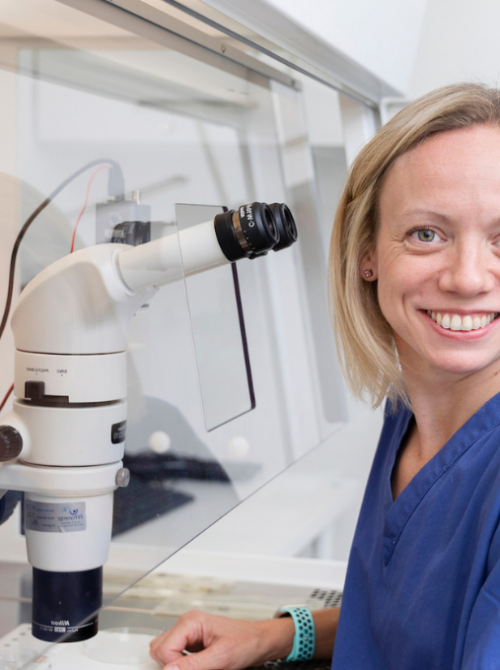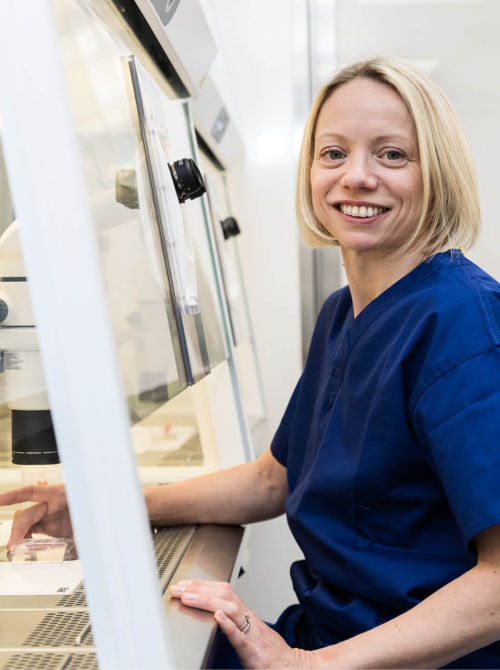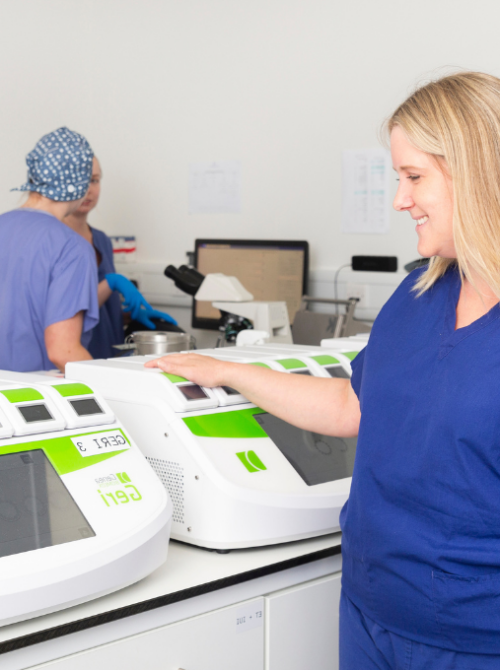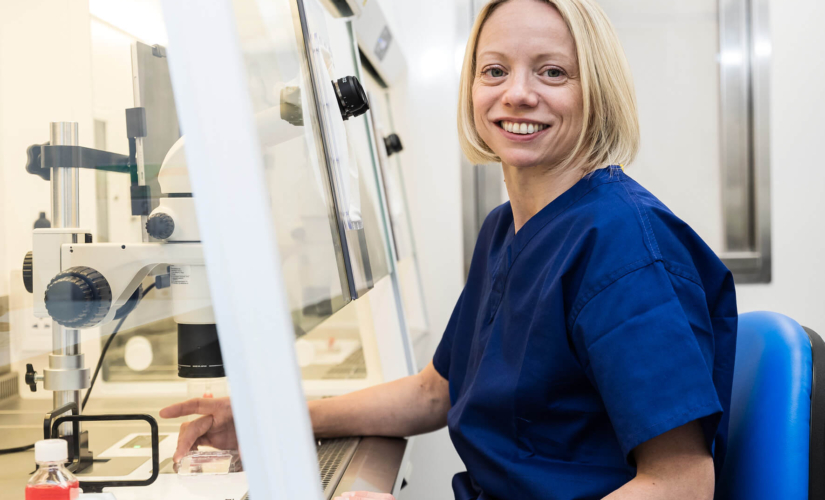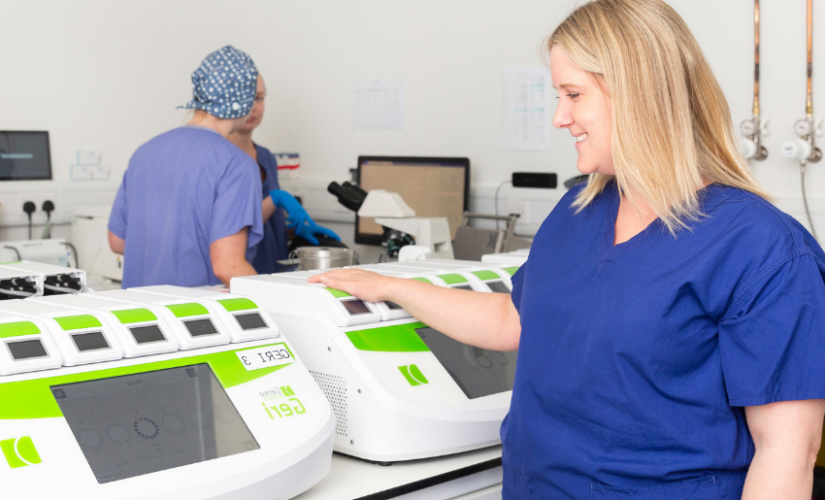How The Evewell grades embryos
Fertility clinics grade embryos with different terminology, so it’s not so easy to compare grading if you’ve had cycles at different clinics.
We asked our lab team to explain how The Evewell grades embryos, and what this means for you.
A lot of our patients ask us about the grades of their embryos or blastocysts. Embryo grading is a topic that has seen its fair share of debate over the years, so we want to spend some time looking at what these grades actually mean.
During IVF, embryos created in the lab are graded by our embryology team to distinguish between good, average and poor-quality embryos, with the ultimate goal of selecting the best embryo for transfer to achieve the highest chance of achieving pregnancy.
Fertility clinics grade embryos with different terminology, so it’s not so easy to compare grading if you’ve had cycles at different clinics.
For the most part, however, they are all noting the same features, which are: inner cell mass, trophectoderm, and degree of expansion.
It’s important to clarify the grading with our team if you have any questions, to ensure you’re receiving the same information.
Why do we grade embryos?
Embryo grading is not an exact science, but it does help when determining which embryos may be suitable for transfer. There are numerous other genetic factors that determine if an embryo will become a viable pregnancy – unfortunately, these can only be deduced by genetic testing or by proceeding with an embryo transfer and seeing what happens.
When grading an embryo, the embryologists are referring to the appearance of the embryo, and it’s important to remember that embryos are only graded on what is visible under the microscope.
When incorporating PGT-A, the grade of an embryo becomes less relevant because the crucial factor at this point is whether the embryo has the correct number of chromosomes.
For example, an embryo with a top-quality grade can return a genetically abnormal result, whereas a more average-looking embryo can be genetically normal. The selection of which embryo to transfer is therefore based on the genetic result and not the embryo grade.
Features of an Embryo
Let’s start out by first defining some terms you might hear embryologists mentioning when they talk to you about your embryo grades.
- Morphology: The appearance of the embryo.
- Compaction: This occurs when the cells start to communicate with each other and cell borders can no longer be defined. This stage usually occurs around late day 3 to day 4 of culture.
- Morula: After the embryo has done a few rounds of cell division, the cells will compact together to form a morula. This typically occurs around day 4 of development in preparation of blastocyst formation.
- Blastocyst: This is the stage of development usually observed on days 5 and 6 of culture. It’s characterized by the presence of an inner cell mass, trophectoderm and blastocoel cavity. Often referred as a “blast.”
- Inner Cell Mass: This is the little cluster of cells on the interior of the blastocyst that develops into the actual foetus.
- Trophectoderm: These are the cells that surround the outside of the blastocyst. They play a role in implantation and eventually become the placenta.
Grading Day 3 Embryos
When we grade embryos on day 3, we use a grading system ranking the embryos on a scale of 1 to 4, with 1 being the best (although confusingly, some clinics may use 4 as the best – which is why you can’t ever compare grading across clinics).
Day 3 embryos ideally consist of 6-8 cells held within an outer “shell” called the zona pellucida. At this stage of development, embryos are graded on:
- Rate of growth (number of cells)
- Degree of fragmentation
- Evenness of cells
Grading Day 5 Embryos (Blastocysts)
From day 3 to day 5, embryos grow to form a blastocyst which is made up of two distinct types of cell: foetal cells (also called the inner cell mass or ICM) and placental cells (also called trophectoderm or TE). The placental cells form the outer layer of the embryo, surrounding the fluid-filled cavity containing the foetal cells.
Blastocyst embryos that are graded after 5 days of growth are graded with a much more complicated system. Blastocyst grading is determined by:
- Degree of expansion based on how expanded the cavity is. This is graded on a scale of 1-6, with 6 being the most expanded.
- Appearance of the inner cell mass which is graded from A – D, with A being the highest quality and D being the poorest.
- Appearance of the trophectoderm, also graded from A – D.
Blastocyst Grading Explained
When you receive a grade for your blastocyst (e.g.: 4AA or 3BC), you’ll notice three different elements; number, letter, letter, with each element referencing one of the below:
NUMBER
The degree of the expansion of the embryo’s cavity
1 = cavity less than half the volume of the embryo
2 = cavity more than half the volume of the embryo
3 = full blastocyst, cavity completely filling the embryo
4 = expanded blastocyst, cavity larger than the embryo with thinning of the shell
5 = hatching out of the shell
6 = fully hatched out of the shell
FIRST LETTER
The inner cell mass quality
A = many tightly packed, compacted cells
B = larger/loose cells, may appear fragmented
C = no cells visible
D = cells appear degenerate
SECOND LETTER
The trophectoderm quality
A = many smooth cells, equal size, forming a neat layer
B = few to moderate numbers of large but healthy cells
C = large or unevenly distributed cells
D = cells appear degenerate
In this method of grading, an embryo grade of 4AA, for example, would be a blastocyst of very good appearance. Any embryo graded 1 or 2 is called an early blastocyst and is too early to distinguish the foetal and placental cells clearly, therefore we do not give them additional lettering.
What is the first step to grading embryos?
The first time you will receive a call from one of our embryologists is for your fertilisation results. This will be the day after your egg collection. There isn’t much assessment that can be done on embryo quality at this point.
Over the next few days, your embryos will be observed by our time-lapse incubators. Unlike other conventional incubators, these have an integrated camera that captures images of each embryo.
These images create a time-lapse video of embryo development which enables the lab team to observe the continual development of each embryo without removing them from the incubator and exposing them to the outside environment.
During the next few days, any fragmentation will be noted. This is a common occurrence in human embryos, and many beautiful babies have resulted from embryos that presented with fragments.
When do you decide the final embryo grade?
The next time your embryos will be looked at is on day 5. Until day 3, the majority of what drives embryo development comes from factors within the egg. After day 3 the embryonic DNA takes over, including the genetic contribution from the sperm.
Once your embryos get to Day 5, Day 6, or on some occasions Day 7, they are classified as a blastocyst, and you will receive the final grading (see previous posts). If you are planning on having a fresh transfer, this will have already been booked to go ahead on Day 5 of embryo development.
However, if you are having PGS, or have opted for a ‘freeze all’ cycle, it is at this point the embryos will be biopsied and/or frozen.
We only freeze embryos that we believe stand a chance at resulting in a successful pregnancy. So, don’t be discouraged if you see a frozen embryo with a grade of “BC.” This just means the trophectoderm looked of lower quality, but still has a shot.
Does embryo grading impact success rates?
Ultimately, the answer is no. Embryo grading will not impact the success rate or outcome of the transfer, but it will help to inform us exactly which embryos to transfer, along with the patient’s age and fertility history.
Whereas an AA quality embryo is the very best an embryo can be graded, healthy babies are born from embryos grade all the way through to a CC quality embryo.
So, it’s important to remember embryo grades are only indicative of the potential to implant and not the final outcome of a pregnancy.
Our goal is to always give our patients the highest chance of a successful pregnancy and a healthy baby. At The Evewell, we aim to transfer blastocysts on Day 5 of a fresh cycle as this is the most optimal time when your uterus is ready to receive an embryo.
Why do embryos fail with good grading?
The major reason why an IVF cycle is not successful is down to the genetics and quality of the embryo. Many embryos are not able to implant after transfer to the uterus because they are flawed in some way.
Even embryos that look good in the lab, and have a good grading, may have defects not visible to the naked eye. One of the major factors in IVF failure is chromosomal abnormalities in the embryo.
However, this is not just related to IVF, but is true for all human embryos, whether naturally conceived or via IVF. These abnormalities are the reason behind most miscarriages, as well as failure to implant during in an IVF cycle.
This is a big factor to consider when reviewing a failed IVF cycle. And something we always stress to our patients is that there is very little you can do to affect the outcome of the cycle once an embryo has been transferred.
I’ve had a failed cycle, what’s next?
When an IVF cycle doesn’t result in a pregnancy, it’s devastating. All of those emotions and energy put into a cycle can be demanding and physically exhausting.
It is absolutely normal to grieve any kind of loss, particularly one you’ve poured your heart and soul into, but try not to blame yourself or your partner.
After your cycle, you will have the opportunity to book a follow-up consultation with one of our fertility consultants, where they will take time to go through the cycle, step by step, explaining what may have happened and what your next options are. Before you commit to a second IVF cycle, assess how you and your partner feel.
